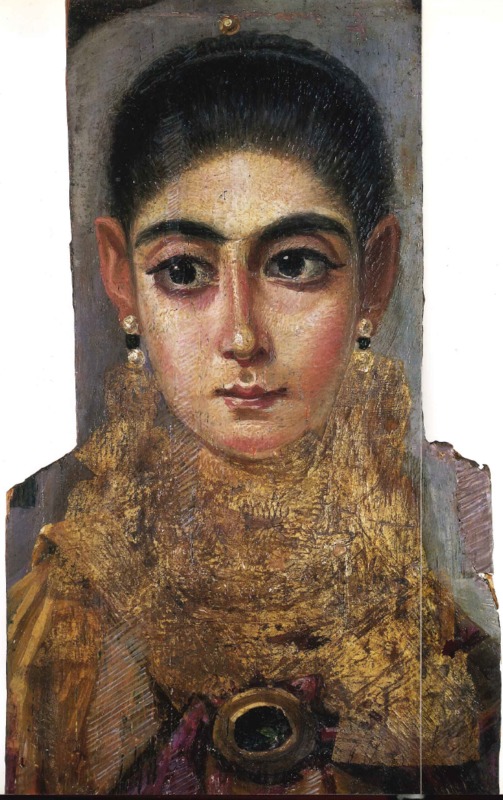"The European"
Title
Date
Artist or Workshop
Materials
Height of the work
Provenience
Current Location
Description and Significance
Description:
This encaustic painting on rectangular cedar wood, known as “L’Européenne,” depicts the portrait bust of a young woman, from her head to her upper body, placed atop a grey-blue background. Her face, an ovular shape with a subtle point at its base, consists of soft, delicate features, including a long, slender nose and teardrop recess above small lips slightly upturned on the right side. Disproportional to these features, her big, pointed ears, characterized by earrings consisting of a black stone set between two pearls, measure to nearly one-third of her facial height. Perhaps most significant, however, are her large, lidded eyes enclosed by smoothly curving brows, which highlight dark, rounded irises that peer out to her right toward the viewer as the focal point. They appear naturalistically rendered, even consisting of blacker pupils at the center, as well as tiny white specks in the upper and lower portions of the irises, which signifies the reflective, watery quality of the eyes, thus adding a lifelike effect. Additionally, the slight shadows at the bottom rims of the eyes and beneath the mouth, and the more prominent ones along the right brow, eye socket, nose bridge, and cheek, create a sense of three dimensions, based on the light coming from the viewer’s left. Whereas the right side of the face includes a greyish-pink blush, the left, brighter and more directly lit, reveals a slight orange tint atop her otherwise pale, almost white skin. Painted with the same small, impressionistic strokes of the face, the subject’s hair consists of fine black strands moving upward and coalescing at the upper head in a braided band, topped by a spherical gold hairpin. In the lower portion of the bust, a slightly worn, gold-leaf cloth piece drapes around her slender neck and shoulders, down to a green, gold-lined brooch just above her chest. Under this scarf-like element rests drapery characterized by a more saturated gold color with purple diagonal folds, which completes her elegant appearance.
Significance:
A rare example of Greco-Roman painting preserved from antiquity, this female portrait expresses the realism common in Egyptian “Fayum portraits” from the 1st and 2nd centuries AD. Its features mark it undeniably as one of these so-called “Fayum portraits,” named for the Fayum oasis in Egypt, 150 miles south of Alexandria, from which many were first excavated by British archaeologist W.M. Flinders Petrie between 1887 and 1889. Although the provenance of this particular piece is unknown, its stylistic characteristics, remarkably similar to those of the Portrait d’Homme Barbu in the Musée des Beaux-Arts de Dijin, suggest that it comes from the more southern Antinoopolis site, uncovered by Egyptologist Albert-Jean Gayet between 1896 and 1911. Created by Roman emperor Hadrian in honor of his companion, Antinous, Antinoopolis was most likely comprised of Greek colonists, including those from Greek settlements in Fayum, who were dubbed, “Antinoans, New Greeks,” by Hadrian and may have brought their illusionistic painting techniques and funerary practices to the new city.
In their original context, portraits such as this one were added to the front of Egyptian mummies decorated with gold-leaf scenes, as a part of a funerary practice aiming to preserve the soul of the individual in the afterlife. It is for this reason that the eyes are enlarged and emphasized, since they enliven the portrait and communicate the person’s soul. While most of paintings from antiquity have not survived, this portrait and others like it exist today as unique specimens because they were preserved in Egyptian desert conditions. Stylistically, they offer fascinating and significant insights into Greco-Roman painting traditions, which likely trace back to the naturalistic techniques of Apelles, Alexander the Great’s official portrait painter, in the 4th century B.C. When Macedonians came to Egypt during Hellenistic times, aspects of Apelles’ style were purportedly incorporated into the Alexandrian school of painting, which eventually developed into the Fayum tradition visible in this portrait. Most notably, this is evident in the encaustic method used to create it, a fine painting technique of Classical Greek origin that was used for realism. For this portrait, the cedar wood would have been prepped with a black coating, before being painted quickly with hot beeswax mixed with pigments, particularly the Greek primaries, white, yellow ochre, red and black, using a brush, and refined with a sharp tool called a cauterium, to blend uneven surfaces together. Given this hasty process, caused by the quick drying time, it is not surprising that the fine, painterly strokes have been compared to impressionism by scholars such as Doxiades. Aesthetically speaking, this portrait, acquired by the Louvre in 1951, derives its name, “the European” from its pale skin, which may be an appropriate label since most of the settlers in Antinoopolis were of Greek origin. Her clothing, consisting of gold drapery, a hairpin, and an emerald brooch, most likely reflects the Greco-Roman fashions, as it was made when Egypt was under Roman Imperial control. Interestingly, the gold-leaf, unlike many other Fayum portraits, where it was applied to the background, is strictly used on her garments. Of all her features, she is best remembered for her “curious gaze”, as her lively eyes look to her right, rather than straight out, marking her distinctiveness among Fayum types and preserving her individual personality, which viewers in the Louvre can still witness today.
References
http://www.museumlab.eu/exhibition/06/about.html
http://www.smithsonianmag.com/history/the-oldest-modernist-paintings-20169750/
http://www.vauchot-conteur.fr/wp-content/uploads/2011/10/AVB28-96-97-FAYOUM.pdf
Doxiadis, Euphrosyne, and Dorothy J. Thompson. The Mysterious Fayum Portraits: Faces from Ancient Egypt. London: Thames & Hudson, 2000. 86-100; 114; 147-150; 213. Print.
Contributor
Citation
Item Relations
This item has no relations.

